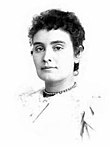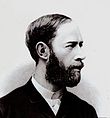Overview of the events of 1887 in science
| |||
|---|---|---|---|
| +... |
| 1887 in science |
|---|
| 18861888 |
| Fields |
| Technology |
| Social sciences |
| Paleontology |
| Extraterrestrial environment |
| Terrestrial environment |
| Other/related |
The year 1887 in science and technology involved many significant events, listed below.
Astronomy
- April – Carte du Ciel project initiated by Paris Observatory director Amédée Mouchez.
- Theodor von Oppolzer's Canon der Finsternisse, a compilation of the 8,000 solar and 5,200 lunar eclipses from 1200 BC until 2161 AD, is published posthumously.
Biology
- Jean Pierre Mégnin publishes Faune des Tombeaux ("Fauna of the Tombs"), the founding work of modern forensic entomology.
- Sergei Winogradsky discovers the first known form of lithotrophy during his research with Beggiatoa.
- The Petri dish is created by German bacteriologist Julius Richard Petri.
Chemistry
- Amphetamine is first synthesized in Germany by Romanian chemist Lazăr Edeleanu, who names it phenylisopropylamine.
- Otto Schott produces 'Normalthermometerglas' (family of Borosilicate glass) for the first time.
Cartography
- Guyou hemisphere-in-a-square projection developed by Émile Guyou.
Climate
- January 28 – In a snowstorm at Fort Keogh, Montana, in the United States, the largest snowflakes on record are reported. They are 15 inches (38 cm) wide and 8 inches (20 cm) thick.
- September 28 – Start of the Yellow River floods in China: 900,000 dead.
Conservation
- June 23 – The Rocky Mountains Park Act becomes law in Canada, creating that nation's first national park, Banff National Park.
Earth sciences
- February 23 – The French Riviera is hit by a large earthquake, killing around 2,000 along the coast of the Mediterranean Sea.
- In Hawaii, the Mauna Loa volcano eruptions subside, having begun in 1843. During the 1887 eruption, about 2½ million tons (2.3 million metric tons) of lava per hour pours out, covering an area of 29 km.
Linguistics

- March 3 – Anne Sullivan begins to teach language to the deaf and blind Helen Keller.
- July 26 – L. L. Zamenhof publishes Lingvo internacia ("International language") under the pseudonym "Doktoro Esperanto".
Mathematics
- Joseph Louis François Bertrand rediscovers Bertrand's ballot theorem.
- Henri Poincaré provides a solution to the three-body problem.
Medicine
- January 11 – Louis Pasteur's anti-rabies treatment is defended in the French Academy of Medicine by Dr. Joseph Grancher.
- August – The U.S. National Institutes of Health is founded at the Marine Hospital, Staten Island, NY, as the Laboratory of Hygiene.
- October 1 – Hong Kong College of Medicine for Chinese founded by Patrick Manson.
- Franz König publishes "Über freie Körper in den Gelenken" in the journal Deutsche Zeitschrift für Chirurgie, first describing (and naming) the disease Osteochondritis dissecans.
- The Hospitals Association establishes the first (non-statutory and voluntary) register of nurses in the United Kingdom.
Physics

- November – The Michelson–Morley experiment is performed, indicating that the speed of light is independent of motion.
- Heinrich Hertz discovers the photoelectric effect on the production and reception of electromagnetic waves in radio, an important step towards the understanding of the quantum nature of light.
Psychology
- November – G. Stanley Hall founds The American Journal of Psychology.
- Richard Hodgson and S. J. Davey, in the course of investigations into popular belief in parapsychology, publish one of the first descriptions of eyewitness unreliability.
Technology
- March 8 – Everett Horton of Connecticut patents a fishing rod of telescoping steel tubes.
- March 13 – Chester Greenwood patents earmuffs.
- June 8 – Herman Hollerith receives a U.S. patent for his punched card calculator.
- July – James Blyth operates the first working wind turbine at Marykirk in Scotland.
- July 19 – Dorr Eugene Felt receives the first U.S. patent for his comptometer.
- August – Anna Connelly patents a fire escape.
- October 18 – Jacob Fitzgerald and William H. Silver are granted a U.S. patent for a "potato masher and fruit crusher", a form of potato ricer.
- November 8 – Emile Berliner is granted a U.S. patent for his Gramophone.
- Adolf Gaston Eugen Fick invents the contact lens, made of a type of brown glass.
- English engineer James Atkinson invents his "Cycle Engine".
- Mexican general Manuel Mondragón patents the Mondragón rifle, the world's first automatic rifle.
- Alfred Yarrow completes the first practical high-pressure water-tube Yarrow boiler, for a torpedo boat.
Organizations
- March 7 – North Carolina State University is established as North Carolina College of Agriculture and Mechanic Arts.
- October 3 – Florida A&M University opens its doors in Tallahassee, Florida.
Publications
- Publication in Barcelona of Enrique Gaspar's El anacronópete, the first work of fiction to feature a time machine.
Awards
- June – William Armstrong created 1st Baron Armstrong of Cragside, the first engineer to be raised to the Peerage of the United Kingdom
- Copley Medal: Joseph Dalton Hooker
- Wollaston Medal for Geology: John Whitaker Hulke
Births
- January 7 – Kurt Schneider (died 1967), German psychiatrist.
- January 15 – Henry Fairfield Osborn, Jr. (died 1969), American conservationist.
- January 28 – Edmund Jaeger (died 1983), American naturalist.
- April 20 – Margaret Newton (died 1971), Canadian plant pathologist.
- June 22 – Julian Huxley (died 1975), English biologist and populariser of science.
- July 30 – Felix Andries Vening Meinesz (died 1966), Dutch geophysicist.
- August 18 – Erwin Schrödinger (died 1961), Austrian physicist.
- September 26 – Barnes Wallis (died 1979), English aeronautical engineer.
- October 11 – María Teresa Ferrari (died 1956), Argentine physician.
- November 10 – Elisa Leonida Zamfirescu (died 1973), Romanian engineer.
- November 19 – James B. Sumner (died 1955), American winner of the 1946 Nobel Prize in Chemistry.
- November 23 – Henry Moseley (killed 1915), English physicist.
- November 25 (November 13 Old Style) – Nikolai Vavilov (died 1943), Russian plant pathologist.
- December 13 – George Pólya (died 1985), Hungarian mathematician.
- December 22 – Srinivasa Ramanujan (died 1920), Indian mathematician.
- December 27 – Edward Andrade (died 1971), English physicist.
Deaths
- January 22 – Joseph Whitworth (born 1803), English mechanical engineer.
- February 26 – Anandi Gopal Joshi (born 1865), Indian physician.
- July 17 – Henry William Ravenel (born 1814), American botanist.
- July 18 – Dorothea Dix (born 1802), American mental health reformer.
- August 2 – Joseph-Louis Lambot (born 1814), French inventor of ferrocement.
- August 15 – Julius von Haast (born 1824), German geologist.
- August 19
- Spencer Fullerton Baird (born 1823), American ornithologist and ichthyologist.
- Alvan Clark (born 1804), American telescope manufacturer.
- October 7 (O.S. September 25) – Lev Tsenkovsky (born 1822), Russian biologist.
- October 17 – Gustav Kirchhoff (born 1824), German physicist.
- November 18 – Gustav Fechner (born 1801), German psychologist.
References
- von Oppolzer, Th. Canon der Finsternisse. Vienna: Kaiserlich-Königliche Hof- und Staatsdruckerei ; repr. with preface by Donald H. Menzel and English translation of the introduction by Owen Gingerich, New York: Dover Publications, 1962.
- Klotzbach, H.; Krettek, R.; et al. (2004). "The history of forensic entomology in German-speaking countries". Forensic Science International. 144 (2–3): 259–263. CiteSeerX 10.1.1.503.3269. doi:10.1016/j.forsciint.2004.04.062. PMID 15364399.
- Winogradsky, S. (1887). "Über Schwefelbakterien". Botanische Zeitung (45): 489–610.
- Snyder, John P. (1993). Flattening the Earth. University of Chicago. ISBN 978-0-226-76746-8.
- "Largest snowflake". guinnessworldrecords.com. Retrieved November 23, 2022.
- "Canada Creates National Park". This Week in History Archives. Parks Canada. Archived from the original on 2004-03-18. Retrieved 2011-04-10.
- Brown, Keith; Ogilvie, Sarah, eds. (2009). Concise Encyclopedia of Languages of the World. Oxford: Elsevier. p. 375. ISBN 978-0-08-087774-7.
- Feller, William (1968). An Introduction to Probability Theory and its Applications. Vol. 1 (3rd ed.). Wiley. p. 69.
- "History & Development". The University of Hong Kong Li Ka Shing Faculty of Medicine. 2006. Archived from the original on 2011-05-13. Retrieved 2011-04-05.
- "The Possibilities of Malobservation and Lapse of Memory from a Practical Point of View". Proceedings of the Society for Psychical Research 4 (Internetversion).
- Price, Trevor J. (2004). "Blyth, James (1839–1906)". Oxford Dictionary of National Biography (Online ed.). Oxford University Press. Retrieved 2014-04-16. (subscription or UK public library membership required)
- Hardy, Chris (2010-07-06). "Renewable energy and role of Marykirk's James Blyth". The Courier (Dundee). D. C. Thomson & Co.
- U.S. Patent No. 366,945, filed July 6, 1886; second patent granted October 11, 1887: U.S. Patent No. 371,496, filed March 12, 1887.
- "Anna Connelly's 1887 patent for a fire escape (Patent No. 368,816)". patents.google.com. US368816A. Retrieved November 23, 2022.
- US371882A.
- U.S. patent 372,786
- Heitz, Robert. "The Kontaktbrille of Adolf Eugen Fick (1887)". XVIIIth Convention of the Julius-Hirschberg-Gesellschaft Oktober 14th–16th 2004 Innsbruck. Archived from the original on 2012-03-05. Retrieved 2012-03-13.
- "Historic Firearm of the Month". Cruffler.com. March 2001. Retrieved 2013-07-05.
- Borthwick, Alastair (1965). Yarrows: the first hundred years. Glasgow: Yarrows. pp. 36–37.
- Westcott, Kathryn (2011-04-09). "HG Wells or Enrique Gaspar: Whose time machine was first?". BBC News. Retrieved 2011-04-09.
- "Copley Medal | British scientific award". Encyclopedia Britannica. Retrieved 23 July 2020.